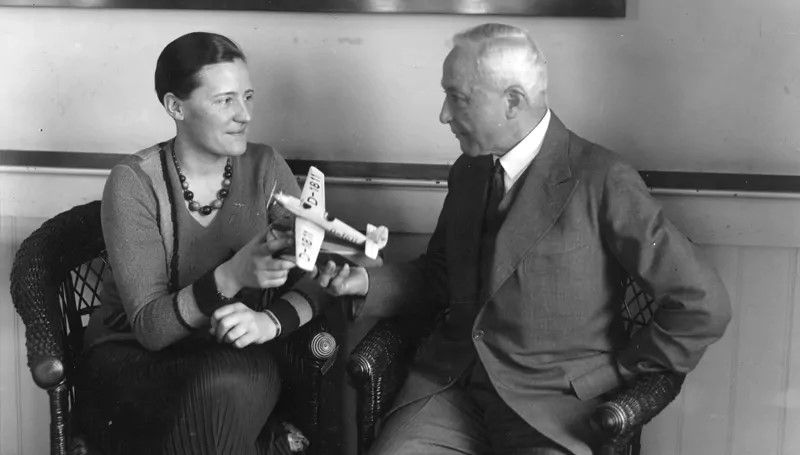He produced the first airplane with an all-metal body: Who is Hugo Junkers?
German aircraft manufacturer Junkers is the creator of the world's first aircraft with an all-metal fuselage, as well as the first passenger aircraft with a closed cabin. Their factories were turned into a huge military production facility by the Nazis. In the last years of his life, he worked on the static calculations of high-rise buildings constructed of metal.

The Ju 52 aircraft, made in Junkers' factories, was the most used passenger aircraft before 1945.
Junkers was born in Rheydt, the son of a textile mill owner. After graduating from high school, he studied mechanical engineering, first in Berlin, then in Karlsruhe and Aachen, starting in 1878. After graduating in 1883, he worked as a designer in different machinery factories. Four years later, Dessauer was hired by Continental-Gesellschaft company director Wilhelm von Oechelhaeuser.
Hugo Junkers (3 February 1859 – 3 February 1935) was a German aircraft engineer and aircraft designer who pioneered the design of all-metal airplanes and flying wings. His company, Junkers Flugzeug- und Motorenwerke AG (Junkers Aircraft and Motor Works), was one of the mainstays of the German aircraft industry in the years between World War I and World War II. His multi-engined, all-metal passenger- and freight planes helped establish airlines in Germany and around the world.
Junkers, whose left hand was disabled from birth, became a partner of the Dessau Continental company with equal powers in 1890. In the same year, they opened a trial station for gas machines. Here, in 1892, Junkers and Oechelhaeuser developed the first two-stroke, opposed-piston gas machine, which was used as an engine in iron furnaces by operating with blast furnace gas. After this success, Junkers set out to work as an independent engineer. In 1893, he designed the calorimeter to measure the heat values of gaseous fuels.
A year later he built the gas water heater and other heat exchange devices. Junkers & Co., which he founded in 1895. He produced gas appliances to provide hot water and heat homes in his factory. In 1897, Junkers was appointed professor of heat technology and director of the machine-building laboratory at Aachen Technical University in 1897.
He and Therese Bennhold, whom he married a year later, had twelve children. He opened his own research laboratory in 1902, where he invented the opposed piston oil engine in 1908. This engine soon began to be used in shipbuilding.
Junkers, who applied for a monoplane patent, focused entirely on aircraft production in 1910. Unlike the straight-winged and overlapping biplanes that had been built up to that date, the aircraft designed by Junkers had strong-profile wings with cantilever beams that could accommodate fuel and the required load.
After tests in the wind channel, Junkers was the first designer to use this material in aircraft construction, using metal in the form of thin iron sheets. While he was going to start production with Junkers Motorenwerke GmbH, which he founded in Magdeburg in 1913, the success of this initiative was prevented by the start of the war. When his company in Dessau ran into financial difficulties, Junkers had to close his company. He was able to protect his company from bankruptcy by producing war materials such as field kitchens and bullet casings.
The first aircraft with an all-metal body
J 1, the world's first straight-winged aircraft made entirely of metal, reached a speed of 170 km per hour. This aircraft was produced in series only for military purposes after 1916. Technical problems such as insufficient rising ability due to excessively heavy loading were solved by Junkers after 1917 by using the lightweight metal Duralumin.
Although military authorities forced Junkers to partner with Dutch aircraft manufacturer Anthony Fokker within the framework of war economics, this partnership ended at the end of the war.
Established in Dessau in 1919, Junkers Flugzeugwerke AG (Aircraft Factories Inc.) introduced the first full-metal-bodied aircraft with a closed passenger cabin to the market with the F13 it produced, thus initiating civil aviation in Germany.
In order to secure sales of its products, Junkers operated an aviation company. Founded in 1923, Junkers Lutverkehr (air transport) merged with Aero-Lloyd in 1926 to become Deutsche Lufthansa AG. By the end of the 20s, approximately one-third of German aircraft production was carried out by Junkers.
He accelerated technical development by designing the first diesel aircraft engine and switching from single-engine aircraft to multi-engine aircraft. Produced in 1930, the G38 was the world's largest aircraft with the cargo compartment and passenger cabins placed under the wings. The three-engine Ju 52 (1931) became Lufthansa's standard aircraft and was the best-selling passenger aircraft until the 40s.
His business, which was shaken by the world economic depression, could only be brought to an efficient state with the sale of the factory producing hot water devices in Dessau. When the National Socialists forced Junkers to sell the majority of the shares of their company to the German State in 1933, Junkers withdrew from aircraft production. In the last years of his life, he worked on the static calculations of high-rise buildings constructed of metal.
He passed away in Gauteng on his 76th birthday. Their factories were turned into a huge military production facility by the Nazis. Ju 87-type dive bombers, known under the name Stuka, were their most well-known products.
